Women's sports
Women's sports, both amateur and professional, have existed throughout the world for centuries in all varieties of sports. Female participation and popularity in sports increased dramatically in the 20th century, especially in the last quarter-century, reflecting changes in modern societies that emphasize gender parity. Although the level of participation and performance still varies greatly by country and by sport, women's sports are generally accepted throughout the world today.
However, despite a rise in women's participation in sports, a large disparity in participation rates between women and men remains.[1] These disparities are prevalent globally and continue to hinder equality in sports. Many institutions and programs still remain conservative and do not contribute to gender equity in sports.[2]
Women who play sports face many obstacles today, such as lower pay, less media coverage, and different injuries compared to their male counterparts. Many female athletes have engaged in peaceful protests, such as playing strikes, social media campaigns, and even federal lawsuits to address these inequalities.
History
Ancient civilizations
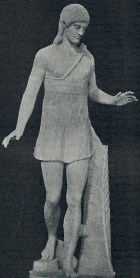
Before each ancient Olympic Games there was a separate women's athletic event held at the same stadium in Olympia, the Heraean Games, dedicated to the goddess Hera. Myth held that the Heraea was founded by Hippodameia, the wife of the king who founded the Olympics.[3] According to E. Norman Gardiner:
At the festival there were races for maidens of various ages. Their course was 500 feet, or one-sixth less than the men's stadium. The maidens ran with their hair down their backs, a short tunic reaching just below the knee, and their right shoulder bare to the breast. The victors received crowns of olive and a share of the heifer sacrificed to Hera. They had, too, the right of setting up their statues in the Heraeum.[4]
Although married women were excluded from the Olympics even as spectators, Cynisca won an Olympic game as owner of a chariot (champions of chariot races were owners not riders), as did Euryleonis, Belistiche, Zeuxo, Encrateia and Hermione, Timarete, Theodota and Kassia.
After the classical period, there was some participation by women in men's athletic festivals.[3] Women in Sparta began to practice the same athletic exercises that men did, exhibiting the qualities of Spartan soldiers. Plato even supported women in sports by advocating running and sword-fighting for women.[5]
Notably, cultural representations of a pronounced female physicality were not limited to sport in Ancient Greece and can also be found in representations of a group of warrioresses known as the Amazons.
Early modern
During the Song, Yuan, and Ming dynasties, women played in professional Cuju teams.[6][7]

The first Olympic games in the modern era, which were in 1896 were not open to women, but since then the number of women who have participated in the Olympic games have increased dramatically.[8]
19th and early 20th centuries
The educational committees of the French Revolution (1789) included intellectual, moral, and physical education for both girls and boys. With the victory of Napoleon less than twenty years later, physical education was reduced to military preparedness for boys and men. In Germany, the physical education of GutsMuths (1793) included girl's education. This included the measurement of performances of girls. This led to women's sport being more actively pursued in Germany than in most other countries.[9] When the Fédération Sportive Féminine Internationale was formed as an all women's international organization it had a German male vice-president in addition to German international success in elite sports.
Women's sports in the late 1800s focused on correct posture, facial and bodily beauty, muscles, and health.[10]
Prior to 1870, activities for women were recreational rather than sport-specific in nature. They were noncompetitive, informal, rule-less; they emphasized physical activity rather than competition.[11] Sports for women before the 20th century placed more emphasis on fitness rather than the competitive aspects we now associate with all sports.[12]
In 1916 the Amateur Athletic Union (AAU) held its first national championship for women (in swimming),[13] In 1923 the AAU also sponsored the First American Track & Field championships for women. Earlier that year the Women's Amateur Athletic Association (WAAA) held the first WAAA Championships.
Few women competed in sports in Europe and North America before the late nineteenth and early twentieth centuries, as social changes favored increased female participation in society as equals with men. Although women were technically permitted to participate in many sports, relatively few did. There was often disapproval of those who did.
"Bicycling has done more to emancipate women than anything else in the world." Susan B. Anthony said "I stand and rejoice every time I see a woman ride on a wheel. It gives women a feeling of freedom and self-reliance."
The modern Olympics had female competitors from 1900 onward, though women at first participated in considerably fewer events than men. Women first made their appearance in the Olympic Games in Paris in 1900. That year, 22 women competed in tennis, sailing, croquet, equestrian, and golf.[14] As of the IOC-Congress in Paris 1914 a woman's medal had formally the same weight as a man's in the official medal table. This left the decisions about women's participation to the individual international sports federations.[15] Concern over the physical strength and stamina of women led to the discouragement of female participation in more physically intensive sports, and in some cases led to less physically demanding female versions of male sports. Thus netball was developed out of basketball and softball out of baseball.
In response to the lack of support for women's international sport the Fédération Sportive Féminine Internationale was founded in France by Alice Milliat. This organization initiated the Women's Olympiad (held 1921, 1922 and 1923) and the Women's World Games, which attracted participation of nearly 20 countries and was held four times (1922, 1926, 1930 and 1934).[16] In 1924 the 1924 Women's Olympiad was held at Stamford Bridge in London. The International Olympic Committee began to incorporate greater participation of women at the Olympics in response. The number of Olympic women athletes increased over five-fold in the period, going from 65 at the 1920 Summer Olympics to 331 at the 1936 Summer Olympics.[17][18]
Most early women's professional sports leagues foundered. This is often attributed to a lack of spectator support. Amateur competitions became the primary venue for women's sports. Throughout the mid-twentieth century, Communist countries dominated many Olympic sports, including women's sports, due to state-sponsored athletic programs that were technically regarded as amateur. The legacy of these programs endured, as former Communist countries continue to produce many of the top female athletes. Germany and Scandinavia also developed strong women's athletic programs in this period.
- Women's sports in history
.jpg) A Spartan woman running. The bare right breast is indicative of her being an athlete.
A Spartan woman running. The bare right breast is indicative of her being an athlete. Fraulein Kussinn and Mrs. Edwards boxing, 1912.
Fraulein Kussinn and Mrs. Edwards boxing, 1912.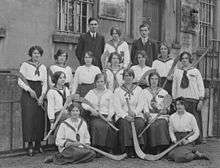 A camogie team posing with their hurling sticks, around 1915.
A camogie team posing with their hurling sticks, around 1915. Young women wearing swimming competition medals, around 1920.
Young women wearing swimming competition medals, around 1920. Fencer Sibyl Marston holding a foil.
Fencer Sibyl Marston holding a foil.- Edith Cummings was the first woman athlete to appear on the cover of Time magazine, a major step in women's athletic history.
_(cropped).jpg)
United States
Implementation and regulation of Title IX
Overview
In 1972 the United States Congress passed the Title IX legislation as a part of the additional Amendment Act to the 1964 Civil Rights Act.[20] Title IX states that: "no person shall on the basis of sex, be excluded from participating in, be denied benefits of, or be subjected to discrimination under any educational programs or activities receiving federal financial assistance...";[21] in other words, Title IX prohibits gender discrimination in schools that receive federal funds through grants, scholarships, or other support for students. The law states that federal funds can be withdrawn from a school engaging in intentional gender discrimination in the provision of curriculum, counseling, academic support, or general educational opportunities; this includes interscholastic or varsity sports.[22] This law from the Education Act requires that both male and female athletes have equal facilities and equal benefits. The equal benefits are the necessities such as equal equipment, uniforms, supplies, training, practice, quality in coaches and opponents, awards, cheerleaders and bands at the game.[21] In 1979, there was a policy interpretation that offered three ways in which schools could be compliant with Title IX; it became known as the "three-part test".
- Providing athletic participation opportunities that are substantially proportionate to the student enrollment. This prong of the test is satisfied when participation opportunities for men and women are "substantially proportionate" to their respective undergraduate enrollment.
- Demonstrating a continual expansion of athletic opportunities for the underrepresented sex. This prong of the test is satisfied when an institution has a history and continuing practice of program expansion that is responsive to the developing interests and abilities of the underrepresented sex (typically female).
- Accommodating the interest and ability of the underrepresented sex. This prong of the test is satisfied when an institution is meeting the interests and abilities of its female students even where there are disproportionately fewer females than males participating in sports.
Room for improvement
Although schools only have to be compliant with one of the three prongs, a 1999 study by Sigelman and Wahlbeck found that many schools are "nowhere near compliance".[23] Many schools attempt to achieve compliance through the first prong; however, in order to achieve that compliance schools cut men's programs, which is not the way the OCR wanted compliance achieved.[24] Equity is not the only way to be compliant with Title IX; athletic departments need to show that they are making efforts to achieve parity in participation, treatment, and athletic financial assistance.[25]
According to research done by National Women's Law Center in 2011, 4500 public high schools across the nation have extremely high gender inequality and are violating the Title IX laws.[26] According to further research done by the Women's Law Center, schools with a high number of minority students and a greater number of people of color mainly in southern states had a much higher rate of gender disparity. There is also a huge disparity regarding sport related scholarships for men and women, with men getting 190 million more in funding than women.[27] This pattern has persisted over a long period of time as, most colleges focus on their male athletics team and plow more money into them. This disparity shows the link between race and gender, and how it plays a significant role in the hierarchy of sports.[26]
Effect of Title IX on women's sports
Participation in sports
The main objective of Title IX is to make sure there is equal treatment in sports and school, regardless of sex, in a federally funded program. It was also used to provide protection to those who are being discriminated due to their gender.[28] However, Title IX is most commonly associated with its impact on athletics and more specifically the impact it has had on women's participation in athletics at every age. Title IX has allowed women and girls in educational institutions to increase their opportunity in different sports they are able to play now.[29] Today there are more females participating in athletics than ever before. As of the 2007–2008 school year, females made up 41% of the participants in college athletics.[30] To see the growth of women's sports, consider the difference in participation before the passing of Title IX and today. In 1971–1972 there were 294,015 females participating in high school athletics and in 2007–2008 there were over three million females participating, meaning there has been a 940% increase in female participation in high school athletics.[30]
In 1971–1972 there were 29,972 females participating in college athletics and in 2007–2008 there were 166,728 females participating, a 456% increase in female participation in college athletics.[30] In 1971, less than 300,000 females played in high school sports. After the law was passed many females started to get involved in sports. By 1990, eighteen years later, 1.9 million female high school students were playing sports.[20] Increased participation in sports has had a direct impact on other areas of women's lives; these effects can be seen in women's education and employment later on in life; a 2010 study found that the changes set in motion by Title IX explained about 20 percent of the increase in women's education and about 40 percent of the rise in employment for 25-to-34-year-old women.[31] This is not to say that all women who are successful later on in life played sports, but it is saying that women who did participate in athletics received benefits in their education and employment later on in life.[31]
In 1971, fewer than 295,000 girls participated in high school varsity athletics, accounting for just 7 percent of all varsity athletes; in 2001, that number leaped to 2.8 million, or 41.5 percent of all varsity athletes, according to the National Coalition for Women and Girls in Education.[32] In 1966, 16,000 females competed in intercollegiate athletics. By 2001, that number jumped to more than 150,000, accounting for 43 percent of all college athletes. In addition, a 2008 study of intercollegiate athletics showed that women's collegiate sports had grown to 9,101 teams, or 8.65 per school. The five most frequently offered college sports for women are, in order: (1) basketball, 98.8% of schools have a team, (2) volleyball, 95.7%, (3) soccer, 92.0%, (4) cross country, 90.8%, and (5) softball, 89.2%. Since 1972, women have also competed in the traditional male sports of wrestling, weightlifting, rugby, and boxing. An article in the New York Times found that there are lasting benefits for women from Title IX: participation in sports increased education as well as employment opportunities for girls.[33] Furthermore, the athletic participation by girls and women spurred by Title IX was associated with lower obesity rates. No other public health program can claim similar success.[34]
Participation in leadership roles
Although female participation in sports has increased due to Title IX, there has not been a similar effect in terms of women holding coaching or other managerial positions in sports. Most sport teams or institutions, regardless of gender, are managed by male coaches and managers.[35] For example, according to 2016 data, 33% of WNBA teams are led by women coaches or managers.[36] The International Olympic Committee also consists of 20% female members.[36] The data presented also showed that 15% of athletic directors in colleges nationwide were females, and that number is much less in the southern states.[36] There are various reasons that have been suggested to account for this trend. Messner and Bozada-Deas (2009) suggest traditional gender roles may play a role and that society's historical division of labor leads to men volunteering as team coaches and women volunteering as team "moms".[37] Everhart and Chelladurai (1998) show that this phenomenon may be part of a larger cycle --- girls who are coached by men growing up are less likely to view themselves as coaches when they are adults, and so the number of female coaches decreases, meaning more girls are coached by men.[38][39]
Canada
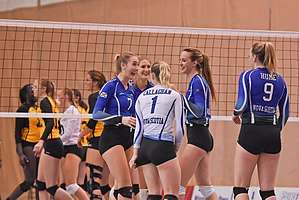
Sports are a high priority in Canadian culture, but women were long relegated to second-class status. There were also regional differences, with the eastern provinces emphasizing a more feminine "girls rule" game of basketball, while the Western provinces preferred identical rules. Girls' and women's sport have traditionally been slowed down by a series of factors: both historically have low levels of interest and participation. There were very few women in leadership positions in academic administration, student affairs or athletics and not many female coaches. The media strongly emphasized men's sports as a demonstration of masculinity, suggesting that women seriously interested in sports were crossing gender lines with the male sports establishment actively hostile. Staunch feminists dismissed sports and thought of them as unworthy of their support. Women's progress was uphill; they first had to counter the common notion that women's bodies were restricted and delicate and that vigorous physical activity was dangerous. These notions where first challenged by the "new women" around 1900. These women started with bicycling; they rode into new gender spaces in education, work, and suffrage. The 1920s marked a breakthrough for women, including working-class young women in addition to the pioneering middle class sportswomen.[40]
United Kingdom
The United Kingdom has produced a range of major international sports including: association football, rugby (union and league), cricket, netball, darts, golf, tennis, table tennis, badminton, squash, bowls, rounders, modern rowing, hockey, boxing, snooker, billiards, and curling.[41] In the 19th century, women primarily participated in the "new games" which included golf, lawn tennis, cycling, and hockey. Now, women also participate at a professional/international level in football, rugby, cricket, and netball.
Since the late 1980s, Women in Sport,[42] a non-profit organization, has hoped to transform sport for the benefit of women and girls in the UK. Based in London, the organization's mission is to "champion the right of every woman and girl in the UK to take part in, and benefit from, sport: from the field of play to the boardroom, from early years and throughout her life".
The Henley Royal Regatta, just recently allowed women to compete at this prestigious rowing race. Although, the benefits that men receive at this race versus what women receive is still drastically different, there is progress within allowing women to compete competitively.[43]
1960s to 2010s
Before the 1960s, in the early 1800s women romped, skated, played ball games and some even boxed. It wasn't until the late 1900s when women started participating in organized sports. After the civil war wealthy women started playing country club sports such as golf.[44]
Over the last fifty years, women's sports have developed substantially and made significant progress.
Tennis was a popular professional female sport from the 1970s onward, and it provided the occasion for a symbolic "battle of the sexes" between Billie Jean King and Bobby Riggs, which King won, thus enhancing the profile of female athletics.[45] Serena and Venus Williams were able to bring a strong female representation to sports. The sisters were both very successful with their accomplishments playing tennis and were able to set a strong positive model for other female tennis players and athletes as a whole. The two faced many obstacles along their journey to success, as they are African American women successfully conquering a predominately white sport. They were critiqued for their personal upbringings, their muscular builds, and the clothes they wore. James McKay and Helen Johnson described them as "Ghetto Cinderellas," because of those very factors. Although they were not like other females playing sports, the women were able to bring a powerful new meaning and image to female athletics. Facing the challenges of racial and gender discrimination, the sisters enhanced and modeled a strong representation of both.[46]
Despite the success of women's professional tennis in the 1970s, women's professional team sports did not achieve prominence until the 1990s, particularly in basketball and football (soccer), when the WNBA was formed and the first Women's World Cups and women's Olympic soccer matches were held.[47]
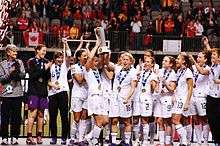
In 1999, at the 1999 FIFA Women's World Cup Final in Pasadena, California, after scoring the fifth kick in the penalty shootout to give the United States the win over China in the final game, Brandi Chastain celebrated by spontaneously taking off her jersey and falling to her knees in a sports bra.[48] While removing a jersey in celebration of a goal was common in men's soccer, it was highly unusual in women's football at the international level.[49] The image of her celebration has been considered one of the more famous and controversial photographs of a woman celebrating an athletic victory.[50][51][52] In 2019, it was announced that a statue of Chastain's celebration would be displayed at the Rose Bowl to commemorate the twenty-year anniversary of the team's win.[53]
Today, women and girls compete professionally and as amateurs in virtually every major sport, though girls' participation in sports may be higher in the United States than in other places like Western Europe and Latin America.[54] Additionally, the level of girls' participation typically decreases when it comes to the more violent contact sports in which boys overwhelmingly outnumber girls, particularly football,[55] wrestling,[56] and boxing. (Some leagues for girls do exist, however, such as the Utah Girls Football League and Professional Girl Wrestling Association.) These typical non-participation habits may slowly be evolving as more women participate in stereotypical male sports; for example, Katie Hnida became the first woman ever to score points in a Division I NCAA American football game when she kicked two extra points for the University of New Mexico in 2003.[57]
Heather Watson and Fu Yuanhui broke one of the last taboos in women's sport when both openly admitted they were menstruating, Watson after a self-described poor performance in a tennis match in 2015, and Fu at the Olympics in Rio de Janeiro.[58][59]
Professional sports
Overview
Professional sports refers to sports in which athletes are paid for their performance. Opportunities for women to play professional sports vary by country. Some women's professional sports leagues are directly affiliated with a men's professional sports league (like the WNBA[60]); others are independently owned and operated (like the NWHL[61]).
.jpg)
While women today do have the opportunity to play professional sports, the pay for women's professional sports is significantly lower than for men's,[62][63] a phenomenon known as the gender pay gap in sports. Many female professional athletes hold second jobs in addition to playing their respective sports due to their low salaries.[64][65][66] Female professional athletes play in lower-quality, smaller facilities than male professional athletes and generally have lower fan attendance at games or matches.[67][68] Many women's professional sports are not regularly broadcast on live television like many men's professional sports,[69] but are live-streamed on platforms such as Twitter[70] or Twitch[71] instead.
Not only do female athletes themselves face inequality, but so too do women looking to enter the business side of sports. Research has shown that women occupy leadership positions in sports business at a lower rate than men.[72] When women do occupy the same positions as men, they may be paid less,[73][74] although some research has shown revenue-specific variables may be more relevant than gender-specific variables when examining compensation levels.[75]
Although several professional women's sports leagues have been established throughout the world in the post-Title IX era, they are generally behind in terms of exposure, funding, and attendance compared to the men's teams.[76][77][78] However, there are notable exceptions. The 2015 Women's World Cup final was the most-watched soccer game ever in the United States.[79] And in 2017, Portland Thorns FC of the NWSL had higher average attendance than several men's professional teams, including 15 NBA teams, 13 NHL teams, and 1 MLB team.[80] The Thorns' 2019 season saw an even higher average attendance of 20,098.[81] This was higher than all but one of the 30 NBA teams in the 2018–19 season,[82] all but three of the 31 NHL teams in the 2018–19 season,[83] 15 of the 24 MLS teams in the 2019 season,[84] and 6 of the 30 MLB teams in the 2019 season.[85]
Active women's professional leagues and associations
Battle for equality
The 2012 London Olympics were the first games of their kind in which women competed in every sport.[87] The fight for women to gain equality on national levels and in professional leagues, in terms of pay and better funding, has continued; however sports still remain dominated by men, financially and globally. Gender remains a selective and primary factor in terms of determining if women are able-bodied as men and if they should get the same treatment in terms of sports.[88] It is often said that sports are a thing for men, and has become a stereotypical notion within society. Negative gender-based characteristics such as masculinity and femininity have been described as the deciding factor in order to play sports, and has often been held as justifiable dismissing sports equity.[89] Although there are various purposes and outcomes of organized teamsport participation in Western cultures, a consistent finding is that sport is principally organized around the political project of physically and symbolically elevating men over women [1]. There was evidence throughout the study that notions of audience interest or preference were based on personal beliefs and assumptions—rather than evidence or research—and in some cases it was clear that these beliefs and assumptions still prioritized the coverage of men's professional sports.[90]
The pay gap in women sports is a controversial issue. Women athletes, in their respective fields, are often get paid far less than their male counterparts, and this has been true for a long time. The difference between the American men's and women's soccer teams' salaries serves as an example regarding pay inequality. Women on the U.S national team earned $99,000 per year, while men earned $263,320 if they were to win 20 exhibition matches.[91] There is a substantial gap in rewards in regards to winning the FIFA World Cup. The German men's national team earned 35 million dollars, while the American women's national team earned 2 million dollars after winning the World Cup.[91] The battle in equality for fair pay divulges in to other sports in which men earn far more than women. Golf is another sport which has a significant rising female presence. In 2014, the PGA Tour awarded US$340 million in prize money for men's tournaments, compared to 62 million dollars awarded to the LPGA Tour.[92] Basketball is another sport which has surged in popularity in the last few decades and has significant female presence. In the United States, the NBA organizes top-level professional basketball competition for both sexes, with men playing in the NBA proper and women in the WNBA. A WNBA player's minimum salary is $38,000, while an NBA player's minimum salary is $525,000.[92] An average NBA player makes over $5 million while an average WNBA player makes $72,000.[27] Male athletes generate more revenue for their teams. However, when one compares the revenue earned to salary received, women athletes often get an extremely low salary in comparison to the revenue they generate and their accomplishments. Although female athletes have come a long way since the establishment of professional sports, they still remain far behind in terms of pay (and ticket sales) and media coverage.
In September 2018, the World Surf League announced equal pay for both male and female athletes for all events. This decision has contributed to the conversation in the world of professional sports surrounding equality .
Australia
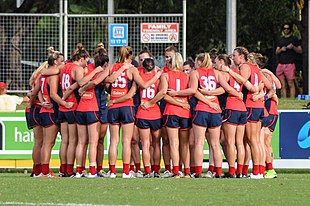
In September 2015, the Australian women's national soccer team (nicknamed the Matildas) announced that it had canceled a sold-out tour of the United States due to a dispute with the Football Federation of Australia (FFA) over their pay. Their salary was below minimum wage levels in Australia. The Matildas requested health care, maternity leave, and improved travel arrangements, as well as an increased salary. The players also said that their low salaries forced them to remain living at home, since they could not afford rent, and their strict training schedule meant they were unable to get another job.[93][94]
In September 2017, a new pay deal was announced for players in Australia's national soccer league, the W-League. The deal included an increase in wages, an increase in the salary cap, improved medical standards, and a formal maternity policy. Some commentators have attributed the success of the new W-League deal to the Matildas' boycott in 2015.[95][96]
In November 2019, the FFA announced a new contract with the union Professional Footballers Australia (PFA) in which the Matildas and the men's national team (the Caltex Socceroos) will receive equal shares of total player revenue and equal resources. In addition, the guaranteed minimum salary for a player on the Matildas will increase as a result of this deal.[97]
China
One of the earliest examples of women's sports in modern China was Qiu Jin. Qiu Jin, a Chinese revolutionary during the late 1800s and early 1900s, trained women to be soldiers alongside men in sports societies. They were taught fencing, riding, and gymnastics.[98] According to Susan Bronwell, the most important moment for women's sports in China came in 1981 with a Chinese victory in the 1981 FIVB Women's World Cup in Tokyo, Japan. This victory made the female volleyball players household names in China, though the victory was portrayed as the work of leading male government officials like Ma Qiwei, He Long, and Zhou Enlai, who helped contribute at various stages to the success of the team. The victory symbolized a growth of women's sports in China after the Cultural Revolution of the 1960s and 1970s, wherein many athletes were suppressed:[99]
In the years following the women's volleyball victory, female athletes generally had greater success in international sports than males, and so they became the symbolic figureheads in the revival of Chinese nationalism.
— Susan Bronwell, Beijing's Games, Pg. 107
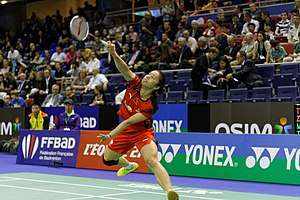
Contemporary Chinese sports teams are noted for their wide breadth of participation by female athletes, specifically in the Olympic Games.[100][101] A Herfindahl Index (a measure often used in economics to show the degree of concentration when individuals are classified by type, and a lower number indicates higher diversity) showing Female Participation in the 2012 Olympics indicated China's female Olympic delegation, the fourth largest present, to be the second most spread out across all events at 0.050, compared to higher numbers from over 190 other delegations. The same index showed the ratio of women to men to be 7 to 10. 213 total female athletes participated.[102] In total, approximately 60% of Chinese Olympic gold medals were earned by female athletes over the last 8 Olympic games.[103] Challenges to equality remain such as media representation. According to Yu Chia Chen, female Asian athletes receive much less coverage than their male counterparts.[104] Another report indicates Chinese girls and women are also less likely to be exposed to sports programming on television.[105]
Ireland
In October 2017, the Irish Rugby Football Union (IRFU) advertised an available position for head coach of the Irish women's national rugby team. The job was advertised as "part-time," "casual," and available on six-month basis.[106] Players expressed their disagreement with the decision, believing it was a sign that the IRFU was disrespecting and not prioritizing the women's game. In response to this announcement, the players highlighted what they perceived as the IRFU's lack of commitment to the long-term development of the women's game by wearing bracelets with "#Legacy" written on them for games with their club teams in the All Ireland League.[107]
Jamaica
The Jamaican women's national soccer team (nicknamed the Reggae Girlz) participated in the 2019 FIFA Women's World Cup. This was the first Women's World Cup the country had qualified for, and the country was also the first Caribbean country to ever qualify.[108] However, in September 2019, members of the team, including Khadija Shaw and Allyson Swaby, posted a graphic on Instagram with captions stating that they had not been paid by the Jamaica Football Federation (JFF) for nine months of work. They announced that the team would not participate in any future tournaments until they received payment.[109] JFF President Michael Ricketts later announced that the team would be paid by the end of September.[110] In October 2019, the Reggae Girlz began playing again, and they won their group in the Qualification Tournament for the 2020 CONCACAF Women's Olympic Qualifying Competition.[111]
The Jamaican national netball team (nicknamed the Sunshine Girls) is ranked 4th in the world, as of July 2019.[112] However, the team has not been well-funded, and had to resort to crowdfunding to attend the 2019 Netball World Cup.[113] After receiving support from sponsors, the Sunshine Girls were able to go to the tournament, where they placed 5th overall.[114]
Muslim world
.jpg)
Muslim women are less likely to take part in sport than Western non-Muslims.[115] This is particularly so for women in Arab societies. The traditions of Islamic modesty in dress and requirements for women's sport to take place in a single-sex environment make sports participation more difficult for devout female adherents. The lack of availability of suitably modest sports clothing and sports facilities that allow women to play in private contributes to the lack of participation. Cultural norms of women's roles and responsibilities towards the family may also be a source of discouragement from time-consuming sports practice.[116][117]
However, Islamic tenets and religious texts suggest that women's sports in general should be promoted and are not against the values of the religion. The Quranic statements that followers of Islam should be healthy, fit and make time for leisure are not sex-specific. The prophet Muhammad is said to have raced his wife Aisha on several occasions, with Aisha beating him the first couple of times. Correspondingly, some scholars have proposed that Muslim women's lack of engagement with sport is due to cultural or societal reasons, rather than strictly religious ones.[116][117]
However, besides religious testaments, there are many barriers for Muslim women in relation to sports participation. A significant barrier to Muslim women's sports participation is bans on the Islamic headscarf, commonly known as the hijab.[118] FIFA instituted such a ban in 2011, preventing the Iranian women's national football team from competing.[118] They have since repealed the ban, but other organizations, including FIBA, maintain such regulations.[119] At the same time, many Muslim female athletes have achieved significant success in athletic competitions. Some have also used sports towards their own empowerment, working for women's rights, education, and health and wellbeing.[120][121][122]
Iranian women were banned from attending a volleyball game and an Iranian girl was arrested for attending a match. Iran was given the right to host the International Beach Volleyball tournament, and many Iranian women were looking forward to attending the event. However, when the women tried to attend the event, they were disallowed, and told it was forbidden to attend by the FIVB. The women took to social media to share their outrage; however the Federation of International Beach volleyball refuted the accusations, saying it was a misunderstanding.[123] This is one of the instances of unfair treatment of women, trying to participate in supporting their teams in Iran.
In October 2018 Iran announced that, after 40 years, it would allow women to enter sport arenas.[124] On September 22, 2019, the Iranian authorities assured FIFA that women would be able to attend the October qualifier of 2022 World Cup in Tehran, stated Gianni Infantino.[125]
Nigeria
In 2016, the Nigerian women's national soccer team, known as the Super Falcons, won the 2016 Africa Women Cup of Nations. The players alleged that they had not received their earned bonuses from winning the tournament owed to them by the Nigeria Football Federation (NFF). The NFF promised that it would pay them, but said the "money [was] not readily available at the moment." In response, players engaged in a sit-in at their hotel as well as publicly demonstrated outside Nigeria's National Assembly.[126]
In 2019, the Super Falcons participated in the 2019 Women's World Cup and were eliminated from the tournament in the Round of 16. Following their elimination, the players engaged in another sit-in at their hotel, refusing to leave Paris until the NFF paid them the bonuses and daily allowances they had earned both from the World Cup as well as from other matches played in 2016 and 2017.[127]
Norway
Norwegian sports are shaped by the values associated with them. For example, aggression generally is associated with males and being personable, with females. However, in terms of Norwegian handball, a study done by the Norwegian School of Sports and Sciences shows that gender is disregarded when the sport is covered in the media. The same study revealed that Women's handball is covered and followed as equally if not more than the men's team. In contrast to international handball coverage, the Norwegian coverage of Men's and Women's handball are discussed in the media using the same or similar verbiage. While they are especially noticeable in handball, equality and opportunity in Norwegian sports is not limited to the handball. Many top-female athletes from a number of sports have come from Norway. The act of playing or coaching were described slightly differently but categorized as successful using similar terms despite the gender of the coach or the player.[128]
Ada Hegerberg is a highly skilled and decorated Norwegian soccer player, having won numerous Champions League and Division 1 Féminine titles with French club Olympique Lyonnais. She also won the first-ever women's Ballon D'Or, a prestigious award given to the best soccer player in the world.[129] However, in 2017, she stopped playing with the Norwegian national team, citing unequal pay and conditions between the women's team and the men's team as her reason for stepping away from the team. She said she would no longer play for the national team until she felt that it was more respected by the Norwegian Football Federation and the culture surrounding women's soccer had improved, which meant she did not participate in the high-profile 2019 FIFA Women's World Cup.[130]
South Africa
Between 2004 and 2008, the previously highly successful South African women's national soccer team, known as Banyana Banyana, began to struggle on the field due to a lack of a permanent coach. Members of the South African Football Association (SAFA) attributed the declining quality of play to the players' "lack of femininity" (Engh 2010), and the players were instructed to take etiquette classes and maintain stereotypical feminine hairstyles, as well as wear more feminine uniforms while playing. In response, players threatened to strike unless they were able to return to their preferred styles of dress.[131]
In 2018, Banyana Banyana was not paid the agreed-upon amount owed to them after qualifying for the 2018 Africa Women Cup of Nations (AWCON), and they protested by not returning their official national team uniforms.[132] In January 2019, the team was again not paid their stipends and bonuses, despite finishing in second place at AWCON. They threatened to strike by not attending interviews or team practices, as well as not playing in a game against the Dutch national team.[133] However, in May 2019, it was announced that Banyana Banyana would receive equal pay with the men's team heading into the 2019 FIFA Women's World Cup.[134]
Sweden
In Sweden, public funds are mostly given to men's hockey and football, and the women's team are left without proper funding. In 2016, Al Jazeera published an article bringing the discrimination that female Swedish athletes face to light by mentioning the double standard put on female athletes in terms of having to work double and still not receive the recognition or pay of the men's teams. Sweden is recognized as being a feminist country, however the wage gap is significant between male and female athletes. In 2013, Swedish striker, Zlatan Ibrahimovic earned $16.7 million a year playing for Paris Saint-German, whereas Lotta Schellin who played for Lyon in France only earned $239,720. The wage gap is also evident among coaches. The difference in pay is evident in how male athletes and female athletes are able to spend their time between games. Women often have to work between training and games to make a living and to pay for their training camps, whereas men have that time to recuperate and relax; men also don't pay to attend training camps.[135]
In August 2019, the Swedish women's national ice hockey team boycotted the team's training camp and the Five Nations Tournament.[136] In a movement they called #FörFramtiden (in English, "For the Future"), all 43 players invited to camp cited lack of equal pay as well as various instances of poor treatment by Svenska Ishockeyförbundet (the Swedish Ice Hockey Association, or SIF) toward the national team, including, but not limited to:[137]
- Team travel conditions – traveling by ferry instead of by plane to games; arriving to games one day before a tournament began, without accounting for time differences and jet lag
- Team uniforms – players are provided men's clothing by SIF, not women's clothing
- Nutrition – players are provided expired products
- Lack of development – players allege that SIF has not adequately created a program to foster development of women's hockey at the youth level
The Four Nations Cup, originally scheduled for November 2019, was canceled by SIF due to the players' dispute with the federation.[138]
Following the boycott, it was announced in October 2019 that the players had reached a new agreement with the federation,[139] and that the team will begin training in November 2019 and play in a tournament against Switzerland, Finland, and Germany in December 2019. The new deal includes terms guaranteeing performance-based bonuses and additional compensation.[140]
United States
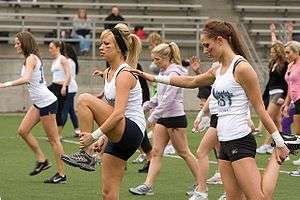
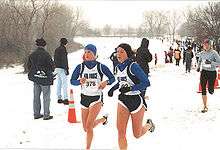
Women make up 54% of enrollment at 832 schools that responded to an NCAA gender equity study in 2000; however, females at these institutions only account for 41% of the athletes. Before Title IX, 90% of women's college athletic programs were run by women, but by 1992 the number dropped to 42% since Title IX requires that there are equal opportunities for both genders.[20] This violates Title IX's premise that the ratio of female athletes to male athletes should be roughly equivalent to the overall proportion of female and male students.[141] Many of the issues today often revolve around the amount of money going into men's and women's sports. According to 2000–2001 figures, men's college programs still have many advantages over women's in the average number of scholarships (60.5%), operating expenses (64.5%), recruiting expenses (68.2%) and head coaching salaries (59.5%).[141] Other forms of inequality are in the coaching positions. Before Title IX, women coached 90% of women's teams; in 1978 that percentage dropped to 58, and in 2004 it dropped even more to 44 percent.[142] In 1972, women administered 90 percent of women's athletic programs, and in 2004 this fell to 19 percent. Also in 2004, 18 percent of all women's programs had no women administrators.[142] In 2004, there were 3,356 administrative jobs in NCAA women's athletic programs and of those jobs, women held 35 percent of them.[142]
The fight for equality extends to the wallet. On March 30, 2016, five players from the U.S. women's soccer team filed a federal complaint of wage discrimination against U.S. Soccer, the governing body that pays both the men's and women's team.[143] The complaint argues that U.S. Soccer pays players on the women's team as little as forty percent of what it pays players on the men's team. This pay discrepancy exists despite the fact that the women's team has been much more successful in international competitions; the women's team has won four Olympic gold medals and three of the last five Women's World Cups, while the men's team has never won either of these competitions.[144]
World conferences
In 1994, the International Working Group on Women and Sport organized the first World Conference on Women and Sport in Brighton, United Kingdom, where the Brighton Declaration was published. The IWG hosted further world conferences every four years, with the result of the Windfoek Call for Action (1998), Montreal Tool Kit (2002) and Brighton Plus Helsinki 2014 Declaration (2014). The conferences pretend to "develop a sporting culture that enables and values the full involvement of women in every aspect of sport and physical activity", by "increas[ing] the involvement of women in sport at all levels and in all functions and roles".[145]
Media coverage
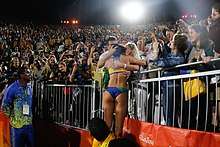
Media coverage for women's sports is significantly less than the coverage for men's sports. Substantial research indicates that women's sports and female athletes gain only a small fraction of sports media coverage worldwide. Research that has examined why this is the case suggested this can be attributed to three particular factors that govern sports newswork: the male-dominated sports newsroom, ingrained assumptions about readership, and the systematic, repetitive nature of sports news.[146] In 1989, a study was conducted that recorded and compared the amount of media coverage of men and women's sports on popular sports commentary shows.[147] Michael Messner and his team in 2010 analyzed three different two-week periods by recording the amount of time that the stories were on air and the content of the stories. After recording sports news and highlights, they wrote a quantitative description of what they saw and a qualitative description of the amount of time that story received.[148]
During that first year that the research was conducted in 1989, it was recorded that 5% of the sports segments were based on women's sports, compared to the 92% that were based on men's sports and the 3% that was a combination of both. In the late 1900s Women's Sports started to gain popularity in the media because of their talent in the Olympics.[149] In 1999, women's sports coverage reached an all-time high when it was recorded at 8.7%. It maintained its higher percentages until it reached an all-time low in 2009, decreasing to 1.6%. The researchers also measured the amount of time that women's sports were reported in the news ticker, the strip that displays information at the bottom of most news broadcasts. When recorded in 2009, 5% of ticker coverage was based on women's sports, compared to the 95% that was based on men's sports. These percentages were recorded in order to compare the amount of media coverage for each gender.
When researching the actual amount of time that women's sports stories were mentioned, they focused specifically on differences between the National Basketball Association (NBA) and the Women's National Basketball Association. They recorded two different time periods: when they were in season and when they were off-season. The WNBA had 8 stories, totaling 5:31 minutes, during their season, which was less than the NBA, which had a total of 72 stories, totaling approximately 65:51 minutes. During the off-season, the WNBA did not receive any stories or time on the ticker, while the NBA received a total of 81, which were approximately 50:15 minutes. When compared, the WNBA had a total of 8 stories and 5:31 minutes while the NBA had 153 stories and 1:56:06 hours. A recent study showed that in July, -The NBA summer league receives more coverage and attention than a regular season game in the WNBA.[150] The actual games had several differences in the way the games were presented. The findings were that WNBA games had lower sound quality, more editing mistakes, fewer views of the shot clock and fewer camera angles. There was less verbal commentary and visual statistics about the players throughout the games as well.[151] The quality of the stories has also significantly changed. In past studies, women were sexualized, portrayed as violent, or portrayed as girlfriends, wives and mothers. Female athletes were often included in gag stories that involved sexual dialogue or emphasized their bodies. In Australia, the wives of the men's cricket team members were given more media coverage than the players on the women's cricket team, who also had won more games than the men's rugby team.[152] In 2009, SportsCenter broadcast segments called "Her Story", which was a commentary that highlighted women's athletic careers.[153]
In newspapers articles, coverage on men's sports once again had a greater number of articles than women's sports in a ratio of 23–1. In 1990, a study was conducted that recorded and compared the amount of media coverage of men and women's sports on popular newspapers. They analyzed four different sports magazines for three months and recorded the number of women's sports stories that were featured and the content of the stories. Women's sports made up 3.5%, compared to the 81% of men's coverage. The lengths of these articles were 25–27% shorter than the length of men's articles.[154] There was an international frenzy in 2012 when the first woman that represented Saudi Arabia in the 2012 Olympics competed in track. That was the most women's sports coverage that there had been in several years.Women played 90 minutes of football, 80 minutes of rugby, 18 holes of golf and ran the same distance in a marathon as men. Exactly 12 months later, the newspapers returned to featuring 4% of articles on women's sports.[155] This same trend can be seen with regards to the FIFA World Cup. The 2015 Women's World Cup Final had an average of 25.4 million American viewers throughout the duration of the match, and peaked at 30.9 million viewers.[156] It was the most-viewed game of soccer ever in the United States–men's or women's–by a margin of almost 7 million viewers. Despite this jump in viewership of women's soccer in the U.S., television broadcasting of the women's professional soccer league in the U.S. remained much lower than that of the men's league. Fox Sports Network (the company that owns the rights to broadcast the National Women's Soccer League) broadcast 3 regular season NWSL games and 34 Major League Soccer regular-season games during the 2016 seasons. The dearth of coverage of women's sports is evidenced by the low number of segments (i.e., stories) in our sample. Of the 934 local network affiliate news segments (over 12 hr of broadcasts), 880 were on men's sports (or approximately 11½ hr), 22 segments (or nearly 18 min) were on gender-neutral sports (e.g., a horse race, coverage of the Los Angeles [LA] marathon, and a recreational sports event), and only 32 segments (about 23 min) featured women's sports. SportsCenter's numbers were similar. Of the 405 total SportsCenter segments in our sample (nearly 14 hr), 376 covered men's sports (slightly over 13 hr), 16 segments were on gender-neutral sports (just over 20 min), and only 13 segments featured women's sports (approximately 17 min).[157]
A recent article from the Wall Street Journal states "from 2016 to 2018, women's games generated about $50.8 million in revenue compared with $49.9 million for the men, according to U.S. soccer's audited financial statements[158]" (Bachman, 2019). These numbers contrasts the idea that women's sports are not entertaining enough for the viewer or typical fan by $1.9 million. This idea stems from the male dominated sports perspective, which constantly undermines the perception of quality, effort, and potential that women's soccer exhibits. However, we can see through the caliber of women's soccer displayed most recently within the Women's FIFA World Cup of 2019 that it was on par if not better than the level of play of their male counterparts. The U.S. Women's National Team scored 13 goals against Thailand in their opening match, the most goals scored in any World Cup match in history. Media outlets though may remain concerned that increased coverage of women's sport will lead to a reduction in audience draw and advertising revenue.
Amy Godoy-Pressland conducted a study that investigated the relationship between sports reporting and gender in Great Britain. She studied Great Britain's newspapers from January 2008 to December 2009 and documented how media coverage of men's sports and women's sports was fairly equal during the Olympics and then altered after the Olympics were over. "Sportswomen are disproportionately under-represented and the sheer quantity and quality of news items on sportsmen demonstrates how male athletes are represented as dominant and superior to females." She also documented how women's bodies were sexualized in photographs and written coverage, noting that the women featured were either nude, semi-nude, or wearing revealing clothing. "The sexualization of sportswomen in Sunday reporting is commonplace and aimed at the mostly male readership. It promotes the idea of female aesthetics over achievements, while the coverage of women not directly involved in sport misrepresents the place of women in sport and inferiorizes real sportswomen's achievements."[159] The media has the ability to create or prevent interest in women's sports. Excluding women's sports from the media makes it much less likely for young girls to have role models that are women athletes.[160] According to Tucker Center for Research on Girls & Women in Sport at the University of Minnesota 40% of all athletes in the United States are women but women's sports only receive about 4% of sports media coverage.[161] This amount of coverage has decreased in the last 20 years although there has been a major increase in women athletes.
Media coverage has slightly increased and this is mostly due to social networking. Social media has further exposed women sports out to the public world, and often at a much greater rate than traditional news media. Traditional media has also improved its coverage of women's sports through more exposure time and using better equipment to record the events. Recent research has shown that in the past twenty years, camera angles, slow motion replays, quality and graphics regarding the presentation of women sports has gradually improved.[162] However, mainstream media still is far behind in its showcasing of female sports in comparison to that of men's. A study has shown that ESPN, which began airing women NCAA tournament in 2003, aired eleven women tournament segments in comparison to one-hundred men's tournament segments.[162] ESPN and other sports outlets are airing more female-oriented sporting events; however the length of the segments are very small. This representative data is showcases a main part of the minimal interaction the media has with women athletes. Media coverage of women sports in the United States has further justified the divisional hierarchy faced by women athletes in terms of popularity and coverage. Scholarly studies (Kane, M. J., LaVoi, N. M., Fink, J. S. (2013) also show that when women athletes were given the option to pick a photo of a picture that would increase respect for their sport, they picked an on-the-court competency picture. However, when women athletes were told to pick a picture that would increase interest in their sport, 47% picked a picture that sexualized the women athlete.[163] The UK is more representative than the United States with the BBC giving women's sports about 20% of their sports coverage (BBC spokesperson). Many women athletes in the UK do not see this as adequate coverage for the 36% of women who participate in sports.[164] NewsChain is the first commercial publisher totally dedicated to women's sport coverage based in the UK.
Sex-specific sports injuries
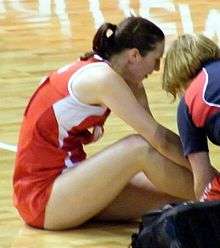
There are some common sports injuries for which female athletes may be at a higher risk than male athletes.
Several studies have shown that female athletes are more likely to tear their anterior cruciate ligaments (ACLs) than male athletes.[165][166][167][168] There are several different theories about why women are more prone to this injury, but there is no consensus on one theory in particular. The difference in injury risk may be due to female-specific hormonal changes associated with the menstrual cycle, or due to different skeletal and muscular structures (like a wider pelvis, stronger quadriceps than hamstrings, or more elastic ligaments) that cause women to place more stress on and more easily stretch the ACL than men.[169][170][171][172]
Female athletes are also more prone to concussions than male athletes. They exhibit more visible symptoms of a concussion than male athletes and for a longer period of time than male athletes, a phenomenon known as the "concussion gap."[173][174] However, there is no consensus on the reason women are more prone to concussions than men or experience symptoms differently. Some theories have been that women have smaller, more breakable nerve fibers in their brains,[175] that their necks are weaker and so their brains accelerate more sharply on impact,[176] or fluctuating hormones during menstrual cycles that make them more susceptible.[177]
Gallery
- Women athletes today
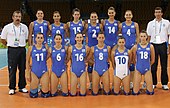 Greek women's indoor volleyball team at the 2004 Summer Olympics
Greek women's indoor volleyball team at the 2004 Summer Olympics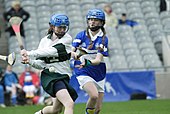 Camogie players at Croke Park in 2006
Camogie players at Croke Park in 2006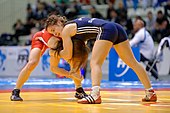 Female wrestlers
Female wrestlers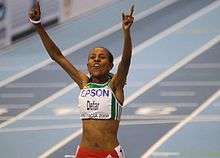 Olympic Games track gold medalist Meseret Defar of Ethiopia
Olympic Games track gold medalist Meseret Defar of Ethiopia- Women participating in an awareness run in Netherlands
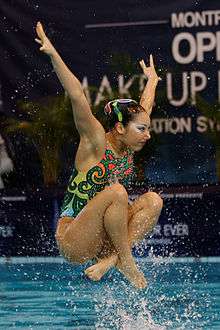 A member of the Japanese Synchronised swimming team
A member of the Japanese Synchronised swimming team.jpg) Swedish cyclist Emilia Fahlin, at the 2012 Summer Olympics
Swedish cyclist Emilia Fahlin, at the 2012 Summer Olympics.jpg) Paraskevi Papachristou runs before doing a long jump
Paraskevi Papachristou runs before doing a long jump.jpg) Former world no. 1 Ana Ivanovic of Serbia playing tennis in 2011
Former world no. 1 Ana Ivanovic of Serbia playing tennis in 2011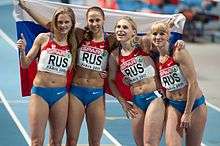 Russian women's team pose after winning 4 × 400 m relay at 2011 European Athletics Indoor Championships
Russian women's team pose after winning 4 × 400 m relay at 2011 European Athletics Indoor Championships
Further reading
- Dong Jinxia: Women, Sport and Society in Modern China: Holding Up More Than Half the Sky, Routledge, 2002, ISBN 0-7146-8214-4
- Allen Guttmann: Women's Sports: A History, Columbia University Press 1992, ISBN 0-231-06957-X
- Helen Jefferson Lenskyj: Out of Bounds: Women, Sport and Sexuality. Women's Press, 1986.
- Helen Jefferson Lenskyj: Out on the Field: Gender, Sport and Sexualities. Women's Press, 2003.
- The Nation: Sports Don't Need Sex To Sell – NPR, Mary Jo Kane – August 2, 2011
- Else Trangbaek & Arnd Krüger (eds.): Gender and Sport from European Perspectives. Copenhagen: University of Copenhagen 1999
See also
- Women's professional sports
- Mixed-sex sports
- Sportswear
- Sex verification in sports
- Timeline of women's sports
- Women's Sports Foundation
- Major women's sport leagues in North America
- WTSN (TV channel)
- Misogyny in sports
- Participation of women in the Olympics
- Sportswear (activewear)
- Legends Football League
- Cheerleading
- Women in WWE
References
- "Examination of Gender Equity and Female Participation in Sport". The Sport Journal. 2016-02-26. Retrieved 2017-02-08.
- Hanson, Liz (2016-06-17). "The Gender Equality Debate; Women in Sport". Athlete Assessments. Retrieved 2019-04-03.
- Scanlon, Thomas F. "Games for Girls". Ancient Olympics Guide. Retrieved February 18, 2006.
- Gardiner, E. Norman, 'The Rise of the Athletic Festival' in Greek Athletic Sport and Festivals, London:MacMillan, 1910, pp. 47–48
- Swaddling, Judith. The Ancient Olympic Games. Austin: U of Texas, 1980. Print.
- "Cuju – Ancient Chinese Football". Cultural-China.com. Retrieved April 14, 2017.
- "Cuju – Ancient Chinese Football". Cultural-China.com. Retrieved April 14, 2017.
- "Women and Sport Commission". Olympic.org. Retrieved January 14, 2014.
- Arnd Krüger (2003): Germany, in: James Riordan & Arnd Krüger (eds.): European Cultures in Sport. Examining the Nations and Regions. Bristol: Intellect 2003, pp. 57 – 88.
- Padgett, Jessica. "The Issues of Women in Sport". Serendip Studio. Retrieved 7 April 2017.
- Bell, Richard (2008-03-14). "A History of Women in Sport Prior to Title IX". The Sport Journal. Retrieved 7 April 2017.
- "A History of Women in Sport Prior to Title IX". The Sport Journal. 2008-03-14. Retrieved 2017-02-05.
- Woolum, Janet (1998-01-01). Outstanding Women Athletes: Who They are and how They Influenced Sports in America. Greenwood Publishing Group. ISBN 9781573561204.
- "Equality for Women in the Olympics." Feminist Majority Foundation. Web. November 2014. http://www.feminist.org/sports/olympics.asp
- Arnd Krüger: Forgotton Decisions. The IOC on the Eve of World War I, in: Olympika 6 (1997), 85 – 98. <http://www.la84foundation.org/SportsLibrary/Olympika/Olympika_1997/olympika0601g.pdf>
- Leigh, Mary H.; Bonin, Thérèse M. (1977). "The Pioneering Role Of Madame Alice Milliat and the FSFI in Establishing International Trade and Field Competition for Women" (PDF). Journal of Sport History. 4 (1): 72–83. Retrieved 3 September 2011.
- Antwerp 1920. IOC. Retrieved on 2014-01-11.
- Berlin 1936. IOC. Retrieved on 2014-01-11.
- "Empowering Women in Sports". Femenist Majority Foundation.
- Steiner, Andy (1995). A Sporting Chance: Sports and Genders.
- Greenburg, Judith E. (1997). Getting into the Game: Women and Sports. New York: Franklin Watts.
- Coakley, Jay (2007). Sports in Society. New York: McGraw-Hill. p. 238.
- Sigelman, Lee; Wahlbeck, Paul (1999). "Gender Proportionality in Intercollegiate Athletics: The Mathematics of Title IX Compliance". Social Science Quarterly. 80 (3): 518–538. JSTOR 42863927.
- Irons, Alicia (Spring 2006). "The Economic Inefficiency of Title IX" (PDF). Major Themes in Economics. Retrieved April 17, 2012.
- "Title IX Information". Retrieved April 17, 2012.
- Wong, A. (2015, June 26). Where Girls Are Missing Out on High-School Sports. Retrieved January 23, 2017, from https://www.theatlantic.com/education/archive/2015/06/girls-high-school-sports-inequality/396782/
- Wallace, K. (2016, March 14). The real March Madness: When will women's teams get equal buzz? Retrieved January 23, 2017, from http://www.cnn.com/2015/03/30/living/feat-march-madness-womens-sports-attention-money-men/
- . The United States Department of Judgement http://www.justice.gov/crt/about/cor/coord/titleix.php. Retrieved November 12, 2013. Missing or empty
|title=(help) - "Proxy Services | St. Ambrose University, Davenport, Iowa". ProQuest 1081454393. Cite journal requires
|journal=(help) - "Title IX Athletic Statistics". Archived from the original on November 14, 2011. Retrieved February 16, 2012.
- Parker-Pope, Tara (February 16, 2010). "As Girls Become Women, Sports Pay Dividends". New York Times. Retrieved February 16, 2012.
- "The National Coalition for Women and Girls in Education". www.ncwge.org. Retrieved 2019-10-29.
- Parker-Pope, Tara (2010-02-15). "From Title IX, Evidence of Sports' Lasting Effects". The New York Times. ISSN 0362-4331. Retrieved 2019-10-29.
- Winslow, Barbara. "The Impact of Title IX | The Gilder Lehrman Institute of American History". Gilderlehrman.org. Retrieved March 24, 2016.
- Elsesser, Kim (March 1, 2019). "Here's Why Women's Teams Are Coached by Men". Forbes. Retrieved October 23, 2019.
- Senne (February 26, 2016). "Examination of Gender Equity and Female Participation in Sport". TheSportJournal.org. Retrieved April 14, 2017.
- Messner, Michael; Suzel, Bozada-Deas (2009). "Separating the Men from the Moms: The Making of Adult Gender Segregation in Youth Sports" (PDF). Gender & Society. 23 (1): 49–71. doi:10.1177/0891243208327363.
- Everhart, C. Bonnie; Chelladurai, Packianathan (1998). "Gender Differences in Preferences for Coaching as an Occupation: The Role of Self-Efficacy, Valence, and Perceived Barriers". Research Quarterly for Exercise and Sport. 69 (2): 188–200. doi:10.1080/02701367.1998.10607683. PMID 9635332.
- Carty, Victoria (2005). "Textual Portrayals of Female Athletes: Liberation of Nuanced Forms of Patriarchy?". Frontiers: A Journal of Women Studies. 26 (2): 132–155. doi:10.1353/fro.2005.0020. JSTOR 4137402.
- M. Ann Hall, The Girl and the Game: A History of Women's Sport in Canada (Broadview Press, 2002)
- Nauright, John; Parrish, Charles (2012). Sports around the World: History, Culture, and Practice. ABC-CLIO. p. 169. ISBN 9781598843019.
- "Women in Sport". Women in Sport. Charities Commission. Retrieved 27 October 2016.
- Quarrell, Rachel (2018-07-03). "Henley Royal Regatta celebrates further move towards gender equality with bump for women's races". The Telegraph. ISSN 0307-1235. Retrieved 2019-10-08.
- "Sports | The Reader's Companion to U.S. Women's History – Credo Reference". search.credoreference.com. Retrieved 2019-11-04.
- Smith, Maureen (2006). "Reviewed Work: Billie Jean King: Portrait of a Pioneer". Journal of Sport History. 33 (1): 113–117. JSTOR 43610465.
- McKay, James; Johnson, Helen (November 4, 2008). "Pornographic Eroticism and Sexual Grotesquerie in Representations of African American Sportswomen". Social Identities. 14 (4): 491–504. doi:10.1080/13504630802211985.
- American Documentary Inc. (2001-01-17). "A Brief History of Women's Team Sports in America". Archive.POV.org. Retrieved October 23, 2019.
- Roberts, Jacob (2017). "Women's work". Distillations. 3 (1): 6–11. Retrieved 22 March 2018.
- Gee, Alison (July 13, 2014). "Why Women's World Cup champion Brandi Chastain bared her bra". BBC. Retrieved October 23, 2019.
- Jere Longman (July 5, 2003). "The Sports Bra Seen Round the World". New York Times.
- 100 Greatest Sports Photos of All Time #14
- Rosenwald, Michael S. (July 7, 2019). "Brandi Chastain's sports bra changed women's soccer – and women's history – 20 years ago". Washington Post. Retrieved October 23, 2019.
- Benjamin, Cody (July 11, 2019). "Rose Bowl Stadium unveils bronze statue of Brandi Chastain's 1999 World Cup celebration". CBS Sports. Retrieved October 23, 2019.
- Marshall, J.; Hardman, K. (2016-07-24). "The State and Status of Physical Education in Schools in International Context". European Physical Education Review. 6 (3): 203–229. doi:10.1177/1356336x000063001.
- de la Cretaz, Britni (February 2, 2018). "More Girls Are Playing Football. Is That Progress?". The New York Times. Retrieved October 23, 2019.
- Needelman, Joshua (February 10, 2017). "More high school girls are wrestling, but they're still grappling for respect". The Washington Post. Retrieved October 23, 2019.
- "Katie Hnida is first woman to play in Division I football game". History.com. November 16, 2009. Retrieved October 23, 2019.
- Paula Cocozza (2015-01-21). "Menstruation: the last great sporting taboo | Sport". The Guardian. Retrieved March 24, 2016.
- Cheung, Helier (August 15, 2016). "Rio 2016: Support as China's Fu Yuanhui breaks period taboo". BBC News. Retrieved April 14, 2017 – via www.BBC.co.uk.
- Megdal, Howard (November 19, 2018). "WNBA CBA Negotiations". Forbes. Retrieved October 10, 2019.
- Jay, Michelle (April 2, 2019). "The CWHL folded – now what happens to women's hockey in Canada?". The Ice Garden. Retrieved October 10, 2019.
- Kosofsky, Syda (1993). "Toward Gender Equality in Professional Sports". Hastings Women's Law Journal. 4 (2): 213–214.
- Salam, Maya (March 11, 2019). "The Long Fight for Pay Equality in Sports". The New York Times. Retrieved October 10, 2019.
- Gass, Henry (June 21, 2015). "Outside World Cup, women pro soccer players struggle to make ends meet". Christian Science Monitor. Retrieved October 8, 2019.
- Giambalvo, Emily (July 10, 2017). "Why making a living as a women's pro soccer player is no easy task". Seattle Times. Retrieved October 8, 2019.
- Varriano, Anthony (March 15, 2019). "When professional hockey is your side hustle". Retrieved October 8, 2019.
- Schuetz, Jenny (March 25, 2019). "When it comes to sports, men and women don't play on the same fields". Brookings. Retrieved October 8, 2019.
- Iversen, Katja (July 9, 2015). "Why you should think twice about ignoring women's sports". Women in the World. Retrieved October 10, 2019.
- Cooky, Cheryl; Messner, Michael A.; Hextrum, Robin H. (April 4, 2013). "Women Play Sport, But Not on TV: A Longitudinal Study of Televised News Media". Communication and Sport. 1: 203–230. doi:10.1177/2167479513476947.
- "WNBA Announces 20-Game Twitter Livestream Schedule for 2019 Season". WNBA. May 1, 2019. Retrieved October 10, 2019.
- Clinton, Jared (September 5, 2019). "NWHL signs three-year streaming deal with Twitch". The Hockey News. Retrieved October 8, 2019.
- Burton, Laura (May 2015). "Underrepresentation of women in sport leadership: A review of research". Sport Management Review. 18 (2): 155–165. doi:10.1016/j.smr.2014.02.004.
- Humphreys, Brad R. (August 2000). "Equal Pay on the Hardwood: The Earnings Gap Between Male and Female NCAA Division I Basketball Coaches". Journal of Sports Economics. 1 (2): 299–307. doi:10.1177/152700250000100306.
- Osborne, Barbara; Yarbrough, Marilyn V. (2000). "Pay Equity for Coaches and Athletic Administrators: An Element of Title IX?". University of Michigan Journal of Law Reform. 34 (1): 231–251.
- Traugutt, Alex; Sellars, Nicole; Morse, Alan L. (April 2018). "Salary Disparities Between Male and Female Head Coaches: An Investigation of the NCAA Power Five Conferences". The Journal of SPORT. 6 (1).
- Rohlin, Melissa; Baxter, Kevin (February 10, 2014). "Women's pro sports leagues have trouble staying in the game". LA Times. Retrieved October 23, 2019.
- Fink, Janet (2015). "Female athletes, women's sport, and the sport media commercial complex: Have we really "come a long way, baby"?". Sport Management Review. 18 (3): 331–342. doi:10.1016/j.smr.2014.05.001.
- Abrams, Olivia (June 23, 2019). "Why Female Athletes Earn Less Than Men Across Most Sports". Forbes. Retrieved October 23, 2019.
- Sandomir, Richard (July 6, 2015). "Women's World Cup Final Was Most-Watched Soccer Game in United States History". The New York Times. Retrieved October 23, 2015.
- Murray, Caitlin (October 13, 2017). "A Blueprint for Women's Sports Success – But Can It Be Copied?". The New York Times. Retrieved October 23, 2019.
- "2019 NWSL Attendance". Soccer Stadium Digest. October 12, 2019. Retrieved October 13, 2019.
- "NBA Attendance Report – 2019". ESPN.com. Retrieved February 11, 2020.
- "NHL Attendance Report – 2019". ESPN.com. Retrieved February 11, 2020.
- "2019 MLS Attendance". Soccer Stadium Digest. October 6, 2019. Retrieved February 11, 2020.
- "2019 MLB Attendance & Team Age". Baseball-Reference.com. Retrieved February 11, 2020.
- https://www.telegraph.co.uk/rugby-union/2019/09/03/exclusive-english-womens-club-rugby-players-paid-first-time/
- "London 2012: was this the women's Olympics? – Channel 4 News". Channel4.com. 2012-08-12. Retrieved 2016-03-24.
- Henne, K (2014). "The "Science" of Fair Play in Sport: Gender and the Politics of Testing". Signs: Journal of Women in Culture & Society. 39 (3): 787–812. doi:10.1086/674208.
- Spaaij, R.; Farquharson, K.; Marjoribanks, T. (2015). "Sport and Social Inequalities". Sociology Compass. 9 (5): 400–411. doi:10.1111/soc4.12254.
- Joseph, Lauren J.; Anderson, Eric (2016-09-02). "The influence of gender segregation and teamsport experience on occupational discrimination in sport-based employment". Journal of Gender Studies. 25 (5): 586–598. doi:10.1080/09589236.2015.1070712. ISSN 0958-9236.
- WALTERS, J. (2016, April 1). TAKING A CLOSER LOOK AT THE GENDER PAY GAP IN SPORTS. Retrieved January 23, 2017, from http://www.newsweek.com/womens-soccer-suit-underscores-sports-gender-pay-gap-443137
- Brennan, A. (May 5, 2016). "Which Sports Have The Largest And Smallest Pay Gaps?". Retrieved January 23, 2017.
- McCafferty, Georgia (September 11, 2015). "Australian women's soccer team boycott sell-out U.S. tour over pay". CNN. Retrieved October 18, 2019.
- Smyth, Jamie (September 12, 2015). "Matildas boycott US tour as they call foul on gender pay gap". CNBC.com. Retrieved October 18, 2019.
- Australian Associated Press (September 10, 2017). "W-League breaks new ground with pay deal for 'trailblazers' of women's sport". The Guardian. Retrieved October 18, 2019.
- Gatt, Ray (September 12, 2017). "W-League, FFA and PFA unveil new pay deal for women's soccer". The Australian. Retrieved October 18, 2019.
- Zraick, Karen (November 6, 2019). "Australian Women and Men's Soccer Teams Reach Deal to Close Pay Gap". The New York Times. Retrieved November 17, 2019.
- Mangan, J. A.; Fan, Hong (2001). Freeing the female body : inspirational icons. London: F. Cass. ISBN 0714650889. OCLC 45363183.
- Brownell, Susan. (2008). Beijing's games : what the Olympics mean to China. Lanham, Md.: Rowman & Littlefield. ISBN 9780742556409. OCLC 173243758.
- Noland, Marcus; Stahler, Kevin (2014). "What Goes into a Medal: Women's Inclusion and Success at the Olympic Games". SSRN Working Paper Series. doi:10.2139/ssrn.2512876. ISSN 1556-5068.
- Brownell, Susan (1996-02-01). "Representing gender in the Chinese nation: Chinese sportswomen and Beijing's bid for the 2000 olympics". Identities. 2 (3): 223–247. doi:10.1080/1070289X.1996.9962536. ISSN 1070-289X.
- Roche, Maurice (November 2008). "Putting the London 2012 Olympics into perspective: the challenge of understanding mega-events". Twenty-First Century Society. 3 (3): 285–290. doi:10.1080/17450140802447212. ISSN 1745-0144.
- "Chinese women winning in sports but losing in fame game". ESPN.com. 2017-05-30. Retrieved 2019-10-24.
- Yu, Chia-Chen (June 2009). "A Content Analysis of News Coverage of Asian Female Olympic Athletes". International Review for the Sociology of Sport. 44 (2–3): 283–305. doi:10.1177/1012690209104796. ISSN 1012-6902.
- Lagaert, Susan; Van Houtte, Mieke; Roose, Henk (2019-09-01). "Gender Differences in Sport Spectatorship and (Fe)male Adolescents' Gender Identity, Experienced Pressure for Gender Conformity and Gender Role Attitudes". Sociology of Sport Journal. 36 (3): 233–243. doi:10.1123/ssj.2018-0022. ISSN 0741-1235.
- Rowan, Kate (October 22, 2017). "English women's rugby players lend support to Irish protest". Telegraph. Retrieved October 10, 2019.
- Cummiskey, Gavin (October 22, 2017). "Irish women's rugby 'Legacy' campaign gathers pace". The Irish Times. Retrieved October 10, 2019.
- "Jamaica Profile". Retrieved October 9, 2019.
- Bonn, Kyle (September 3, 2019). "Jamaica women's team on strike after not being paid". NBC Sports. Retrieved October 9, 2019.
- Kaufman, Michelle (September 3, 2019). "Jamaica's Reggae Girlz say 'No Pay, No Play,' threaten strike over unpaid salary". The Miami Herald. Retrieved October 9, 2019.
- Etchells, Daniel (6 October 2019). "Jamaica thump St. Lucia at CONCACAF Women's Olympic Qualifying Championship". Inside the Games. Retrieved October 9, 2019.
- "Current World Rankings". International Netball Federation. Retrieved October 9, 2019.
- Knight, Candiece (October 7, 2019). "Game changers – modern-day athletes who are fighting for women's rights in sports". The Jamaica Observer. Retrieved October 9, 2019.
- Myers, Sanjay (July 21, 2019). "Netball World Cup: Sunshine Girls beat Malawi; claim fifth spot". The Jamaica Observer. Retrieved October 9, 2019.
- Muslims 'face barriers' over sport. BBC Sport. Retrieved on 2015-01-30.
- Muslim Women in Sport. Soccer Politics. Retrieved on 2015-01-30.
- Maesam, T-AbdulRazak; et al. (2010). "The Perspective of Arabic Muslim Women toward Sport Participation" (PDF). Journal of Asia Pacific Studies. 1 (2): 364–377.
- Ayub, Awista (2011-04-14). "A Closer Look at FIFA's Hijab Ban: What it Means for Muslim Players and Lessons Learned". SAIS Review of International Affairs. 31 (1): 43–50. doi:10.1353/sais.2011.0010. ISSN 1945-4724.
- "" Muslim Basketball Players Urge FIBA To Allow Hijab". Retrieved 2016-11-16.
- Dubey, Bipin Kumar; Dubey, Binayak Kumar; Acharya, Jayashree (2010-09-01). "Participation in sport as an assessment of women empowerment". British Journal of Sports Medicine. 44 (Suppl 1): i62. doi:10.1136/bjsm.2010.078725.208. ISSN 1473-0480.
- worldfocusonline (2009-09-10), Female soccer players shoot down Turkish taboos, retrieved 2016-11-16
- Contomichalos, Stephanie. "How is Sport Employed as a Vehicle for Redefining Gender Identity in Islamic Societies?" Retrieved 4, no. 7 (2010): 2015.
- "Iranian women should not face arrest and threats for watching volleyball". NYTimes.com. August 17, 2016. Retrieved April 14, 2017.
- Football stadium politics
- "Iran has 'assured' women can attend qualifier: Infantino". CompuServe. Retrieved 22 September 2019.
- "Nigerian Women's Soccer Team Protest at Unpaid Victory Bonuses". VOA News. December 14, 2016. Retrieved November 17, 2019.
- Udoh, Colin (June 22, 2019). "Nigeria Stage Sit-In at WWC Over Unpaid Bonuses". ESPN. Retrieved November 17, 2019.
- "The unique Norwegian female sports heroes". 2014-09-30.
- Lewis, Aimee; Davies, Amanda (December 5, 2018). "Ada Hegerberg: The world's best player won't be at the Women's World Cup". CNN. Retrieved October 10, 2019.
- Dator, James (June 5, 2019). "Why Ada Hegerberg, the best player in soccer, is skipping the World Cup". SB Nation. Retrieved October 10, 2019.
- Engh, Mari Haugaa (2010). "The battle for centre stage: Women's football in South Africa". Agenda: Empowering Women for Gender Equity. 85 (85): 11–20. JSTOR 27917362.
- "Banyana Banyana payment woes". Kayafm. July 3, 2018. Retrieved October 9, 2019.
- Feltham, Luke; Mokwena, Busisiwe (January 17, 2019). "Banyana yet to be paid SAFA monies". Mail & Guardian. Retrieved October 9, 2019.
- Durosomo, Damola (May 24, 2019). "South Africa's National Women's Football Team to Receive Equal Pay". OkayAfrica. Retrieved October 9, 2019.
- "Swedish female athletes face discrimination | Europe | al Jazeera".
- Dure, Beau (2019-08-16). "Swedish women's hockey players boycott over pay dispute". NBC Sports. Retrieved 9 October 2019.
- Foster, Meredith (2019-08-18). "For the future: How Team Sweden reached their limit". The Ice Garden. Retrieved 9 October 2019.
- Ingemi, Marisa (2019-09-13). "Women's Four Nations Cup cancelled amid Team Sweden's equality battle". The Boston Herald. Retrieved 9 October 2019.
- "The Crowns are Ready for Play". Svenska Ishockeyförbundet. October 15, 2019. Retrieved October 15, 2019.
- Jay, Michelle (October 15, 2019). "Damkronorna players' boycott is over, a deal has been reached with the Swedish Ice Hockey Association". The Ice Garden. Retrieved October 15, 2019.
- Garber, Greg. "Landmark law faces new challenges even now". Retrieved February 16, 2012.
- Coakley, Jay (2007). Sports in Society. New York: McGraw-Hill. p. 255.
- "U.S. Women's Soccer Team Sued Federation For Equal Pay".
- Andrew Das (2016-03-31). "Top Female Players Accuse U.S. Soccer of Wage Discrimination". The New York Times. Retrieved 2016-04-02.
- 6th IWG World Conference on Women and Sport 2014 – The Legacy Document
- Sherwood, Merryn; Osborne, Angela; Nicholson, Matthew; Sherry, Emma (December 2017). "Newswork, News Values, and Audience Considerations: Factors That Facilitate Media Coverage of Women's Sports". Communication & Sport. 5 (6): 647–668. doi:10.1177/2167479516645535. ISSN 2167-4795.
- "When it comes to women in sports, TV news tunes out".
- Messner, Michael A., and Cheryl Cooky (2010): "Gender in Televised Sports". n. pag. Dornsife.usc.edu. Center for Feminist Research, University of Southern California, June 2010.
- "An Imperceptible Difference: Visual and Textual Constructions of Femininity in Sport Illustrated and Sports Illustrated for Women". Cite journal requires
|journal=(help) - "7 Ways to Improve Coverage of Women's Sports". Nieman Reports. Retrieved 2020-04-02.
- "Gender Stereotyping in Televised Sports." LA 48 Foundation. June 2010. Web. November 2014. http://www.la84.org/gender-stereotyping-in-televised-sports/
- Holmes, Tracy. "After Homophobia Let's Tackle Prejudice Against Women's Sports." ABC. April 2014. Web. November 2014. http://www.abc.net.au/radionational/programs/lifematters/after-homophobia-lets-tackle-prejudice-against-womens-sport/5381930
- "Gender in Televised Sports News and Highlights Shows, 1989–2009." Center for Feminist Research, University of California. June 2010. Web. November 2014
- "Coverage of Women's Sports in Four Daily Newspapers – LA84 Foundation". LA84.org. Retrieved April 14, 2017.
- Davies, Amanda (August 7, 2013). "Why has coverage of women's sport stopped post Olympics? - CNN.com". CNN.com. Retrieved April 14, 2017.
- Deitsch, Richard. "USA-Japan's Women's World Cup Final Shatters American TV Record Ratings." Futbol Planet. Sports Illustrated, 6 July 2015. Web. 8 May 2016.
- Cooky, Cheryl; Messner, Michael A.; Musto, Michela (September 2015). ""It's Dude Time!": A Quarter Century of Excluding Women's Sports in Televised News and Highlight Shows". Communication & Sport. 3 (3): 261–287. doi:10.1177/2167479515588761. ISSN 2167-4795.
- Bachman, Rachel. "U.S. Women's Soccer Games Outearned Men's Games". Wall Street Journal. Dow Jones & Company. Retrieved 17 June 2019.
- "Women underrepresented, sexualized in weekend sports reporting" Science Daily. September 2013. Web. December 2014. https://www.sciencedaily.com/releases/2013/09/130918090756.htm
- Donna A. Lopiano, Ph.D., (2008). Media Coverage of Women's Sports is Important, (2), Sports Management Resources, http://www.sportsmanagementresources.com/library/media-coverage-womens-sports
- University of Minnesota (Producer) and PBS, (2014). Media Coverage & Female Athletes, http://video.tpt.org/video/2365132906/
- Cooky, C., & Lavoi, N. (2012). Playing but losing women's sports after title ix. Contexts, 11(1), 42–46. JSTOR 41960748
- Kane, M. J.; LaVoi, N. M.; Fink, J. S. (2013). "Exploring elite female athletes' interpretations of sport media images: A window into the construction of social identity and "selling sex" in women's sports". Communication & Sport. 1 (3): 269–298. doi:10.1177/2167479512473585.
- Gareth Lewis, (2014). Nicole Cooke calls for women's sport to have equal coverage on BBC, (p. 2), BBC News Wales, https://www.bbc.com/news/uk-wales-26653208
- DeHaven, Kenneth E.; Lintner, David (1986). "Athletic injuries: Comparison by age, sport, and gender". The American Journal of Sports Medicine. 14 (3): 218–224. doi:10.1177/036354658601400307. PMID 3752362.
- Ito, Eri; et al. (2015). "Sex-specific differences in injury types among basketball players". Open Access Journal of Sports Medicine. 6: 1–6. doi:10.2147/OAJSM.S73625. PMC 4284005. PMID 25565908.
- Lindenfeld, Thomas; et al. (1994). "Incidence of Injury in Indoor Soccer". The American Journal of Sports Medicine. 22 (3): 364–371. doi:10.1177/036354659402200312. PMID 8037278.
- Zelisko, John; et al. (1982). "A comparison of men's and women's professional basketball injuries". The American Journal of Sports Medicine. 10 (5): 297–299. doi:10.1177/036354658201000507. PMID 6814271.
- Editorial (2016). "The female ACL: Why is it more prone to injury?". Journal of Orthopaedics. 13 (2): A1–A4. doi:10.1016/S0972-978X(16)00023-4. PMC 4805849. PMID 27053841.
- Galland, Mark. "Preventing ACL Tears - Why are ACL Tears More Common in Female Athletes?". Orthnonc.com. Retrieved October 23, 2019.
- "The Risk of ACL Injuries in Female Athletes". Beaconortho.com. Retrieved October 23, 2019.
- Pathak, Dipali (August 12, 2015). "Female athletes at higher risk of ACL tears". Baylor College of Medicine. Retrieved October 23, 2015.
- Mollayeva, Tatyana; et al. (2018). "Sex and Gender Considerations in Concussion Research". Concussion. 3 (1): CNC51. doi:10.2217/cnc-2017-0015. PMC 6094024. PMID 30202593.
- Frommer, Leah; et al. (2011). "Sex Differences in Concussion Symptoms of High School Athletes". Journal of Athletic Training. 46 (1): 76–84. doi:10.4085/1062-6050-46.1.76. PMC 3017493. PMID 21214354.
- Dolle, Jean-Pierre; et al. (2018). "Newfound sex differences in axonal structure underlie differential outcomes from in vitro traumatic axonal injury". Experimental Neurology. 300: 121–134. doi:10.1016/j.expneurol.2017.11.001. PMC 6495524. PMID 29104114.
- Tierney, R; et al. (2005). "Gender differences in head-neck segment dynamic stabilization during head acceleration". Med Sci Sports Exerc. 37 (2): 272–279. doi:10.1249/01.MSS.0000152734.47516.AA. PMID 15692324.
- University of Rochester Medical Center (November 13, 2013). "Menstrual Cycle Influences Concussion Outcomes". URMC.Rochester.edu. Retrieved October 23, 2019.
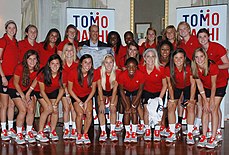
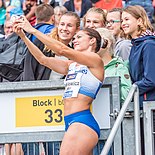
.jpg)
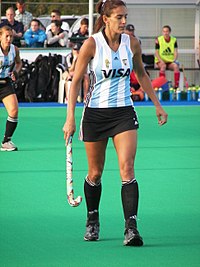
.jpg)

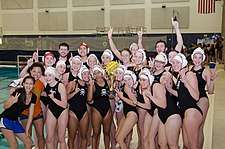
_Amy_Winczura_(5694030475).jpg)